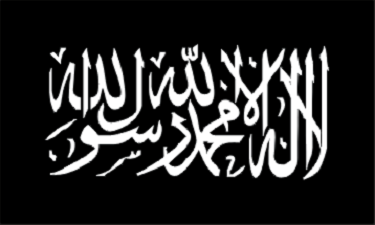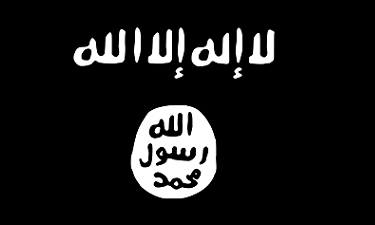Inscription on the flag of the Mahdi’s army?
[ by Charles Cameron — how to tell an authentic Mahdist “black banner” — from a false flag, perhaps? ]
.
There has been considerable talk about black flags featuring the Shahada:
This is the creed of Islam, and reads, “There is not God but God, and Muhammad is the Prophet of Allah.”
And more recently, of black flags featuring the seal of Muhammad:
When the ISI adopted the flag, it issued a statement in 2007 explaining its design. In the statement, the group relates oral traditions portraying Mohammad’s battle flag as either black or white (other traditions say yellow) with the words “No god but God, Mohammad is the messenger of God” written on it. The ISI chose black for its flag because most accounts say the Prophet’s flag was black, and chose the Muslim testimony of faith because many accounts said it was written on the Prophet’s flag.
For the second half of the testimony of faith, “Mohammad is the messenger of God,” the ISI reproduces the Prophet’s seal. They contend that the seal’s design is preserved in Ottoman manuscripts and its three-lined text, “God/Messenger/Mohammad,” is mentioned in oral traditions about the Prophet. They have added this seal to their flag, they explain, because some Muslim scholars say that it appeared on the Prophet’s flag.
**
I therefore thought it worth noting that al-Islam.org — which presents Islam “with particular emphasis on Twelver Shia Islamic school of thought” — has a section on The Slogan on the Flag of the Uprising in Chapter 7, The Uprising of the Imam of the Time (‘atfs) of Najmuddin Tabasi‘s An Overview of the Mahdi’s (‘atfs) Government, which reads:
Every government has a flag by which it can be recognized, and uprisings and revolutions also have particular flags whose logos bespeak of the objectives of their leaders. The global revolution of Hadrat al-Mahdi (‘a) has also a specific flag on which a slogan has been inscribed. Of course, although there are differences with respect to the slogan on his flag, there is a common point in all the statements and that is: It invites the people to obey him (‘a).
Now, it would suffice to mention some pertinent instances:
It has been recorded in a hadith: “It is thus written on the flag of Hadrat al-Mahdi (‘atfs): ‘Listen and obey him’.”
Elsewhere, we read: “The slogan of al-Mahdi’s (‘atfs) flag is al-bay‘atu lillah (the allegiance for the sake of Allah).”
**
Just a little different, eh?
Well, that’s it — just a footnote to ponder.





April 30th, 2013 at 11:38 pm
Is there a handy image of the mahdist flag?
May 1st, 2013 at 5:17 pm
I haven’t seen one proposed by the Shia, Omar. But since Moqtada al-Sadr named his militia the Jaish al-Mahdi I thought it might be worth looking for their flag, and found this paragraph in a piece by Nir Rosen in Boston Review:
That would have been in 2003.
.
I also wondered whether the Khorasan ahadith would be featured in current Shia thinking, and found this in one of the back issues of Current Trends:
A little later in the same piece, we read:
Here’s the thing, Omar. I glean what I can where I can, but I lack the (many) languages to delve deeper into what I find. And while for the people who wave them, whether in Siberia or Somalia, the black banners have a decidedly intense meaning, that meaning is religious (which many journos would like to gloss over) and specifically apocalyptic (even less interesting) — and the banners themselves are emblems at that (not as real nor as easily quantified as militiamen and munitions) — so they’re not always reported…
.
I guess if i didn’t feel so damned ignorant, I wouldn’t keep looking.